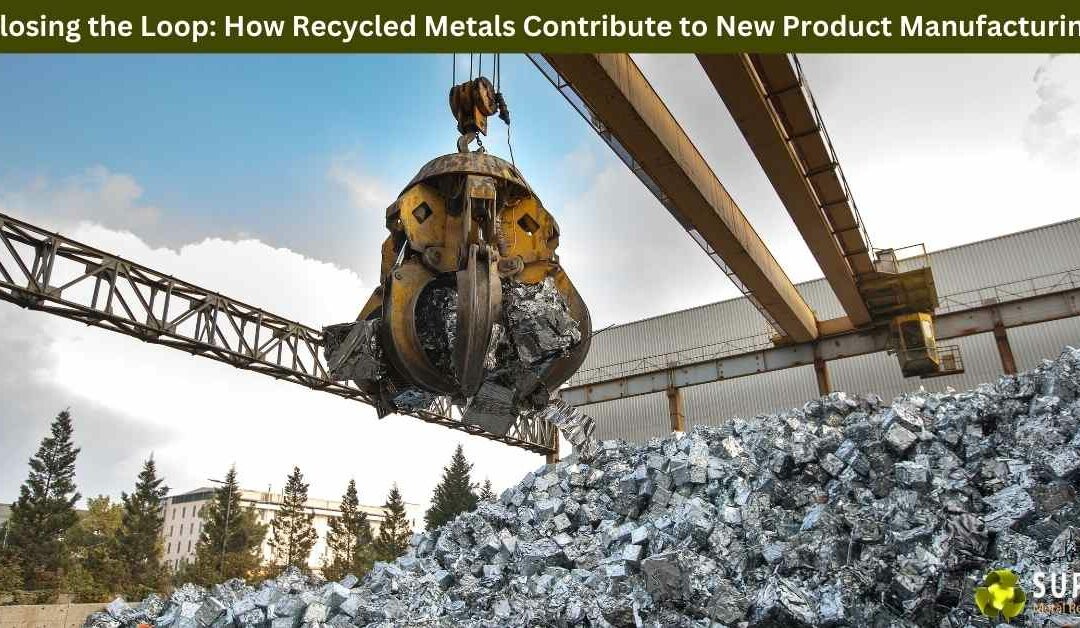In the quest for sustainable development, the concept of “closing the loop” has become a pivotal strategy. This approach emphasizes the recycling and reusing of materials to create a circular economy, minimizing waste and reducing the need for raw material extraction. Recycled metals play a crucial role in this process, offering significant environmental and economic benefits. This article explores how recycled metals contribute to new product manufacturing, the benefits of using recycled metals, and real-world examples of successful implementation.
The Importance of Recycling Metals
Metals are highly recyclable, making them ideal candidates for creating a circular economy. Recycling metals involves collecting and processing used metal products to produce new raw materials, which can then be used in manufacturing new products. This process not only conserves natural resources but also reduces energy consumption and environmental impact.
Key Benefits of Metal Recycling
Resource Conservation:
Mining and extracting virgin metals require extensive resources and result in significant environmental degradation. Recycling metals reduces the need for new mining operations, conserving natural resources like ores and minerals.
Energy Efficiency:
Producing metals from recycled materials uses significantly less energy than manufacturing from virgin materials. For instance, recycling aluminum saves up to 95% of the energy required to produce it from bauxite ore.
Reduced Greenhouse Gas Emissions:
Lower energy consumption translates to fewer greenhouse gas emissions. Recycling metals helps mitigate climate change by reducing the carbon footprint associated with metal production.
Waste Reduction:
Recycling metals diverts waste from landfills, reducing pollution and the environmental impact of waste disposal. It also promotes the efficient use of materials that would otherwise be discarded.
How Recycled Metals are Used in New Product Manufacturing
The integration of recycled metals into new product manufacturing is a testament to the advancements in recycling technologies and sustainable practices. Here’s a closer look at how different industries utilize recycled metals:
Automotive Industry
The automotive industry is one of the largest consumers of recycled metals. Recycled steel, aluminum, and copper are used extensively in the production of vehicles. For example, aluminum is favored for its lightweight properties, contributing to fuel efficiency and reduced emissions in cars and trucks.
Example:
- Ford Motor Company uses recycled aluminum to produce parts for its F-Series trucks, significantly reducing the weight of the vehicles and improving fuel efficiency.
Construction Industry
The construction sector relies heavily on recycled metals for building infrastructure and components. Recycled steel is commonly used in the construction of buildings, bridges, and other structures due to its strength and durability.
Example:
- The Sydney Opera House utilized recycled steel in its construction, demonstrating the feasibility and benefits of using recycled materials in large-scale projects.
Electronics Industry
Recycled metals are integral to the electronics industry, where materials like gold, silver, and copper are recovered from electronic waste (e-waste) and used to manufacture new electronic devices. This not only conserves precious metals but also addresses the growing problem of e-waste.
Example:
- Apple’s recycling program, known as Apple Renew, recovers valuable metals from old devices to create new products, supporting the company’s sustainability goals.
Packaging Industry
Aluminum and steel are widely used in packaging materials such as cans and containers. Recycling these metals helps meet the demand for packaging while reducing the environmental impact.
Example:
- Coca-Cola uses recycled aluminum to produce beverage cans, significantly reducing energy consumption and raw material use.
The Recycling Process: From Scrap to New Products
The journey of recycled metals from scrap to new products involves several key steps:
Collection and Sorting:
Scrap metals are collected from various sources, including households, businesses, and industrial sites. They are then sorted based on type and quality to ensure efficient processing.
Shredding and Melting:
The sorted metals are shredded into smaller pieces to facilitate melting. They are then melted in furnaces at high temperatures, separating impurities and producing pure metal.
Purification and Solidification:
The molten metal undergoes purification processes to remove any remaining contaminants. It is then solidified into ingots or sheets, which serve as raw materials for manufacturing new products.
Manufacturing:
The recycled metal ingots or sheets are transported to manufacturing facilities, where they are transformed into new products through processes such as casting, rolling, and forging.
Case Studies: Successful Implementation of Recycled Metals
Tesla’s Gigafactory
Tesla’s Gigafactory in Nevada is a prime example of incorporating recycled metals into manufacturing. The factory produces batteries for electric vehicles using recycled nickel, cobalt, and aluminum. This initiative supports Tesla’s commitment to sustainability and reduces reliance on virgin materials.
ArcelorMittal’s Circular Economy Model
ArcelorMittal, a global steel manufacturing giant, has embraced the circular economy model by integrating recycled steel into its production processes. The company’s efforts include using scrap steel to manufacture new steel products, reducing energy consumption and greenhouse gas emissions.
Dell’s Closed-Loop Recycling Program
Dell Technologies has implemented a closed-loop recycling program, where plastics and metals from old electronics are recovered and used to produce new computers and electronic devices. This program not only reduces waste but also promotes sustainable production practices.
Challenges and Future Prospects
While the benefits of using recycled metals are clear, several challenges remain:
- Quality Control: Ensuring the purity and quality of recycled metals can be difficult, requiring advanced technologies and stringent quality control measures.
- Economic Viability: Fluctuating prices of recycled metals and the cost of recycling processes can impact economic viability.
- Regulatory Hurdles: Compliance with environmental regulations and standards can be complex and costly.
Despite these challenges, the future prospects for recycled metals in manufacturing are promising. Advances in recycling technologies, increasing consumer demand for sustainable products, and supportive regulatory frameworks are driving the growth of the recycling industry.
Conclusion
Closing the loop through the use of recycled metals in new product manufacturing is a crucial step towards achieving a sustainable and circular economy. The environmental and economic benefits are substantial, from conserving natural resources and reducing energy consumption to minimizing waste and lowering greenhouse gas emissions. As industries continue to innovate and adopt sustainable practices, the integration of recycled metals will play an increasingly important role in creating a greener and more sustainable future. By embracing these practices, businesses can contribute to environmental conservation, enhance their brand reputation, and achieve long-term success.
If you are in Mordialloc, Victoria 3195, and looking for a metal recycling service, this is the best way to visit us.
Super Metal Recycling
345 Frankston – Dandenong Road, Dandenong South VIC 3175
(03) 9706 4909


Recent Comments